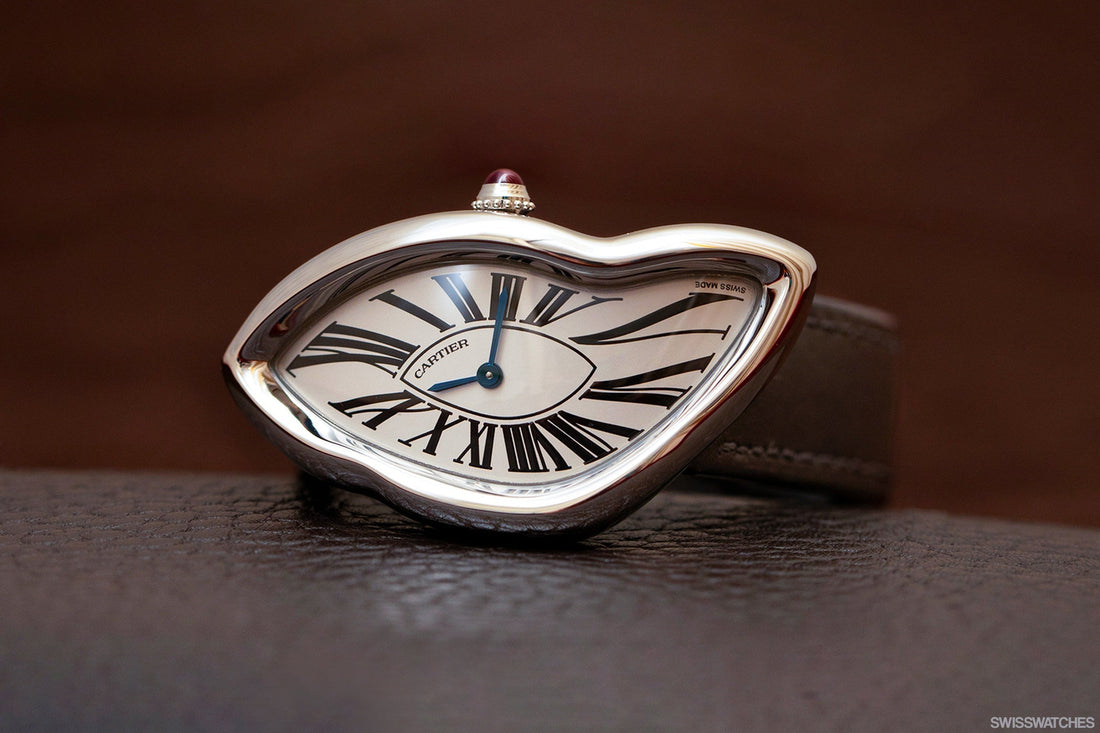

Warped and a little weird, the Cartier Crash watch stands out against Cartier’s typical catalogue.
Its unveiling in the 60s floored the industry. Cartier dared to explore asymmetry in a way that no other brand had. The Crash became a legend for its looks alone. That status grew as stories about the Crash circulated in the industry. Some true. Some embellished. Some straight-up false.
Cartier Crash’s history (yes – its real history) is fascinating. Today, we’re digging into famous Cartier Crash myths and controversies, as well as what really inspired that quirky, art-forward design.
Cartier Crash myths
Certain myths about Cartier Crash’s history just won’t die. And we can see why. They’re usually more exciting, romantic and media-friendly than technical details.
In helping to get the story straight, here are some commonly shared Cartier Crash myths.
A car accident inspired the Crash
The legend says a Cartier Baignoire Allongée watch found itself deformed – almost melty – following a car crash. The surreal shape then supposedly inspired designers to come up with the Crash.
The watch’s name backs up the story, so you can see why this myth went viral, and why some people out there remain convinced it’s an accurate origin story.
Salvador Dalí’s artwork was the muse
The Persistence of Memory is a piece of surrealist art by Salvador Dalí, which depicts soft, melting watches on a dreamy landscape.
That has to be the inspiration behind the Crash, no? Some people think so. It’s a satisfying connection, but it’s likely this is just another busy myth.
Cartier Crash controversies
Cartier Crash controversies have mostly emerged through no fault of Cartier itself. This is an industry where fraudsters and counterfeits have a real impact, and it’s caused confusion for many Cartier Crash prospective owners.
Authenticity & originality debates
The history of the Cartier Crash hasn’t all been smooth-sailing.
One “super rare” Crash was auctioned off for USD $453,600 at Phillips in New York in 2024. Although it was said to have an all-original dial, myth-buster Perezcope noticed inconsistencies and suggested it wasn’t an original.
Perezcope broke down exactly why this was a “trash Cartier Crash”.
All high-end watchmakers can fall victim to the counterfeit market, but stories like these often put sellers on high alert, and can damage the brand itself.
Authentication difficulties
In the same thread as the fake 1970s Crash, many fake watches or reconstructed parts have muddied the waters for Cartier over the years.
Because early production was so limited (and Cartier continued that theme for exclusivity), authentication has often proved difficult.
Our tip? Take your timepiece to an expert to make sure it’s genuine.
What was the real origin of the Cartier Crash?
With so much hearsay, dramatisation, fakes and dupes around the Crash, we wanted to ground the story with some truth. Here are some highlights of the Cartier Crash’s history.

01
The Crash was born in 1967 in Cartier London
Jean-Jacques was in charge. He exercised a level of creative freedom that broke Cartier out of its usual, well-formed box.
The real inspiration behind the Crash was far removed from car accidents and artwork, but is just as colourful.
The Swinging Sixties set a scene of non-conformism in London. Following the more rigid 50s, youths challenged the status quo and enjoyed freedom in lifestyle and fashion. Cue mini skirts, go-go boots, and radical designs.
Jean-Jacques worked with designer Rupert Emmerson to channel the spirit of the 60s into a watch that became iconic of the era: Surreal, bold, and rebellious.

02
The distortion all happened on purpose
Many believe the design came from an unfortunate car accident with the Maxi Oval (Baignoire Allongée) watch.
Take a look at the Crash and Baignoire side-by-side, and it’s easy to see why that myth grew legs. That’s because the Baignoire was a muse for the Crash, but the distortion was intentional.
The irregular curves of the Cartier Crash were realised by “pinching the ends at a point and pulling a kink in the middle” of the Maxi Oval design, said Jean-Jacques.

03
Rupert Emmerson helped design the watch
British designer Rupert Emmerson drew the Cartier London by hand.
Before the final version was agreed upon, he presented iterations to Jean-Jacques, including a watch with an intentionally “cracked” dial to emulate a real crash.
Although Jean-Jacques wanted to shatter the mould with this one, he felt the broken dial was a little too far. Emmerson pulled it back slightly, and the surreal Cartier Crash we know today was born.
Own a Cartier Crash
Many collectors choose a timepiece because of its legacy, and the Cartier Crash has a beautiful one.
Cartier stepped out of its comfort zone to create something that not only defined an era, but lives on today. The story fascinates collectors and investors. With its own unique culture and a buzz that never seems to die, the Crash is coveted, difficult to source, and comes with a premium price tag.
Luckily, you have your personal weapon: Trilogy Jewellers. Our rich industry network means we can source ultra-rare and vintage timepieces, like the Cartier Crash.
Call our showroom to find out more: 0203 9298227.
TRILOGY ON YOUTUBE
Follow Trilogy on YouTube for regular updates and reviews of luxury watches and jewellery.

